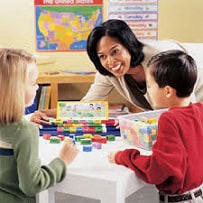4 Research-Based Strategies Parents & Teachers Can Use to Teach Basic Math

|
Getting your Trinity Audio player ready...
|
When teaching math to kids, it is important to follow the natural progression of how they learn best. When children learn language, they first learn the name on an object by someone else pointing to it or touching it and saying the name. For example, a parent points to and touches the family dog while saying “doggy.” After the parent does this so many times, the child begins to identify the dog, pointing to it on his/her own and saying “doggy.”
As the child grows, they begins to form a mental picture in their mind of a dog. They learn to draw a picture of a dog or describe a dog from memory. The child has gone from a concrete understanding (seeing the dog and identifying it) to an abstract understanding (picturing the dog in their mind). Keep this approach in mind when teaching math foundations and basic math facts.
Here are four strategies to help students go from concrete to more abstract understanding.
1. Teach With Manipulatives
Using math manipulatives allows children to understand math concepts in a concrete way first, eventually leading to an abstract understanding. For example, exposing your child to shapes that she can see and touch allows her to obtain the initial concrete understanding of shapes and ultimately leads to an abstract understanding or mental image of the shape.
Having an abstract understanding of math facts is crucial for mastery of math concepts. Children learn best when they are taught concepts in different ways. When learning shapes, give them opportunities to see the shape, feel it, and hear a description of the shape (e.g., this is a triangle, it has three sides, here are the three sides). Over time, have them identify and describe the shape to you.
After they have mastered the concrete understanding of the shape, remove the manipulative and have them identify the shape from a picture, draw the shape, and/or describe the shape to you to check if they have developed an abstract understanding.
Melissa & Doug Shapes – Chunky Puzzle (shown below) is a great example of shape manipulatives.
Manipulatives are also an excellent way to teach the four operations (addition, subtraction, multiplication, and division). For example, show your child ten objects broken into rows of two, with five in each row, to help her understand 5 x 2 = 10, 5+5 = 10, or 10/5 = 2, such as in the picture below.

After showing her how to do it, allow her to set up the objects herself, practicing different examples, to drive the concept home even further. Concrete understanding of basic facts can lead to abstract understanding so students can learn to visualize basic math problems in their mind.
Related Article: 6 Ways to Teach Basic Math Concepts with Transformers

Number lines, such as Carson Dellosa Student Number Lines Desk Tape, which can be taped to a table or desk for easy access, are another tool children can use to solve addition and subtraction problems. For example, you can have your child start at the number 12, count back three on the number line and end up at 9. Then have him write down, 12 – 3 = 9.
It is important to note that according to mathematical research, the number line presents an obstacle for some children because they use it incorrectly when trying to solve equations. Teaching students how to use the number line through explicit instruction is crucial if we was our students to use this mathematical aid correctly. The number line is one aid that should be used in conjunction with others, such as the other tools discussed in this article.
Addition 0-12 Flash Cards

Subtraction 0-12 Flash Cards

Multiplication 0-12 Flash Cards

Division 0-12 Flash Cards



You can use a card like the one above to teach how addition and subtraction are related. Cover up the sum (11) so the child can only see 8 and 3 and ask them what the sum of 8 + 3 is, or cover up the difference (3) so the child can only see 11 and 8 and ask them what the difference of 11 – 8 is.You can also use three sided cards the same way to practice multiplication and division facts. He is an example of a three sided multiplication/division flash card.

The Effects of Direct Instruction (DI) Flashcards and Math Racetrack on Multiplication Facts for Two Elementary Students with Learning Disabilities
The Effects of Flashcards and Student Selected Reinforces with Goals and Additional Practice with Multiplication Facts for Two Intermediate Elementary Students with Behavior Disorders
Apps and computer games have become a common method used in classrooms because they allow students to see pictures accompanied with verbal math problems or explanations. Many teachers use the IPAD and IPAD math apps, to allow students to play math games in which graphics are part of the learning experience. You can also find several free math apps for your tablet or SmartPhone.
Let’s say you are teaching 3 + 4. Write 3 + 4 = ? at the top of a piece of paper. Have your child draw three circles on one side of the paper and four circles on the other. Then ask her to color one group the color of her choice, and the other group a color of your choice (or a different color). After she colors the circles, have her count them and write down the sum where the question mark goes. See an example below:

For a subtraction game try this: If the equation is 12 – 3. Have your child count out twelve pieces of a favorite food and put them on a plate (e.g., 12 Cheerios). Let him eat three pieces, counting backwards each time he eats one, and then counting how many are left (provide as much guidance and assistance as he needs, fading out your guidance as his skills improve over practice sessions). This activity allows your child to visually see the math problem 12-3 happening right before his eyes and he gets to participate in making it happen. Have him write the equation down 12 – 3 = 9, when done.

Try different foods and different equations to keep the learning process going!
For a fun multiplication game, try this. Practice 6 X 2 by giving your child two pieces of celery and asking her to put six raisins on each piece. Have her count the raisins at the end and explain how she got her answer. Have her write on paper, 6 X 2 = 12. Try this game with different equations and different foods. Again provide as much assistance as needed. See an example below:

Division
For division, put 12 raisins (of course you can use other food choices or objects) on the table. Have your child divide the raisins into separate groups of six. Ask her how many groups of six she made. This activity gives a visual representation of 12 ÷ 2 = 6. See an example below:

Give Choices
Let children choose from different methods when solving equations during flash card practice or other assignments, such as using manipulatives, number lines, pen and paper, counting on their fingers, or solving problems in their mind, etc. Whatever methods your child is most comfortable with are acceptable
Remember to always stay calm when working with a child or student, even if you think they should be getting something that they are not getting. If you get frustrated with them, they may start to feel anxious, angry, inferior, stupid, etc. which will lead to a less productive learning session. Keep practice sessions short (5 to 10 minutes for children who get easily frustrated and 10 to 15 minutes for children who can work for longer periods without frustration), unless the child is eager to keep going.






